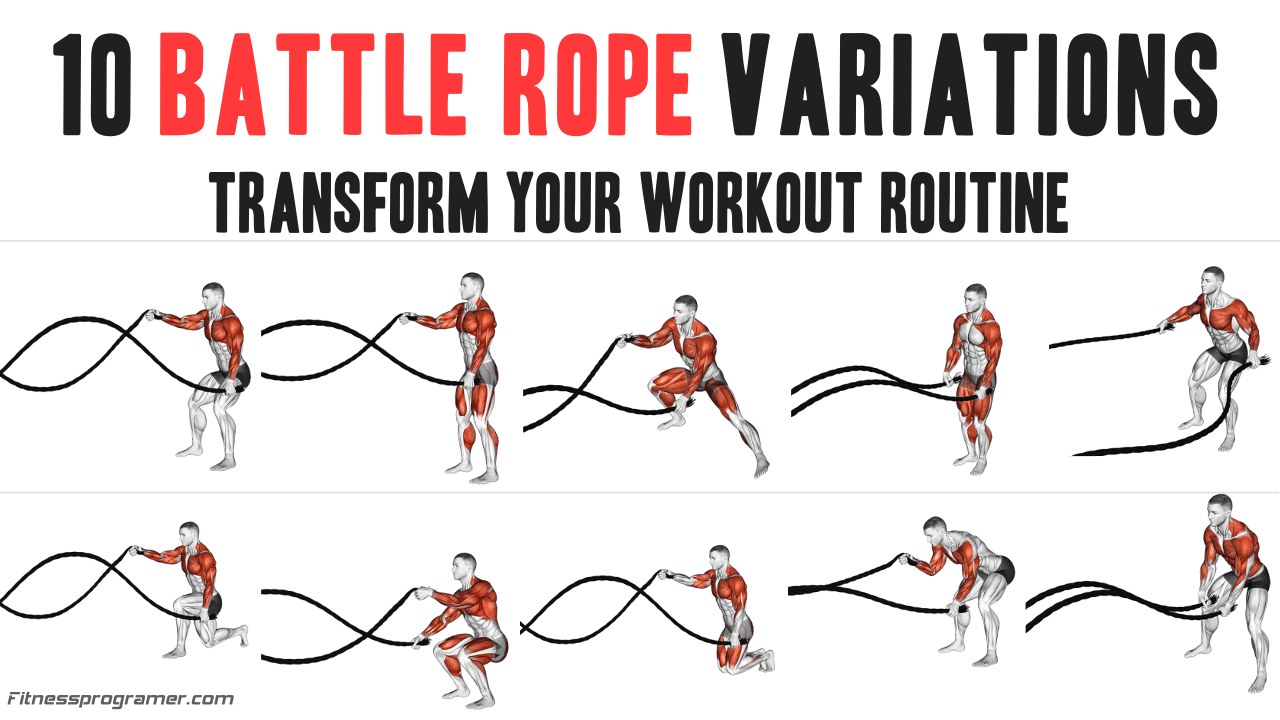Contents
- What Are Battle Ropes?
- Benefits of Battle Rope Exercises
- 10 Battle Rope Variations to Elevate Your Workout
- 1. Half Kneeling Battling Rope:
- 2. Alternating Waves with Kneeling Get-Ups:
- 3. Battle Rope Power Slams:
- 4. Battle Rope Low Waves:
- 5. Battle Rope High Waves:
- 6. Alternate Arms Jump Squat:
- 7. Alternating Lateral Lunge Waves:
- 8. Battle Rope Wave Squats:
- 9. Battle Rope Fly Whips:
- 10. Battle Rope Outside Circles:
- Getting Started Safely with Battle Ropes
Battle ropes, once confined to elite athlete training facilities, have become a staple in gyms worldwide and for good reason! These thick, heavy ropes can be intimidating at first, but with the right guidance, they’re an excellent tool for building strength, burning calories, and enhancing cardiovascular fitness. Let’s explore everything you need to know to safely incorporate battle ropes into your fitness routine, plus a few exercises that you can try today.
Battle rope exercises involve holding one end of each rope in each hand and creating waves, slams, and other dynamic movements. The primary focus of battle rope exercises is on the upper body, especially the shoulders, arms, and core, but they can also engage the lower body when combined with movements like squats or lunges.

What Are Battle Ropes?
Battle ropes are long, durable ropes, usually anchored to a fixed point, used for various high-intensity training exercises. They’re thick and often weigh several pounds, creating resistance that challenges muscles in the arms, shoulders, core, and legs. Battle ropes range from 30 to 50 feet in length and 1.5 to 2 inches in diameter, with different weights to accommodate various fitness levels.
Benefits of Battle Rope Exercises
Battle rope workouts are a powerful way to boost both aerobic and anaerobic fitness, providing an intense full-body workout that builds strength, endurance, and cardiovascular health. With their dynamic motion, battle ropes engage multiple muscle groups while challenging grip strength, core stability, and overall coordination. Let’s dive deeper into why battle ropes make such an effective addition to any training routine. Key Benefits of Battle Rope Training:
1. Enhanced Cardiovascular Fitness
Studies show that even a quick 10-minute session of battle rope exercises can significantly improve cardiorespiratory fitness (1,2,3). This short-duration, high-intensity workout elevates heart rate and energy expenditure, enhancing cardiovascular capacity and overall endurance. By combining resistance training with cardio, battle ropes offer an efficient way to boost heart health, and they serve as a low-impact alternative to high-impact cardio exercises, reducing strain on your joints.
2. Total-Body Engagement
Battle ropes target multiple muscle groups simultaneously, making them a unique total-body workout tool. They engage the shoulders, arms, back, and core, while incorporating the legs in exercises like squats and lunges. This not only builds upper body strength but also promotes core stability, balance, and muscular endurance.
3. Calorie-Burning Power
Battle rope exercises are highly effective at burning calories. The fast-paced, rhythmic motions increase heart rate quickly, helping you burn up to 10 calories per minute, depending on the intensity and duration of the workout. This makes battle ropes a great choice for those aiming to boost calorie burn and fat loss while maintaining muscle.
4. Improved Muscular Endurance and Grip Strength
With continuous rope movements, battle rope exercises build muscular endurance and significantly improve grip strength. The resistance provided by the ropes challenges the muscles in the forearms, hands, and wrists, strengthening your grip and preparing you for other strength training exercises.
5. Core Stability and Balance
The constant movement and resistance of battle ropes activate the core muscles, requiring stability to maintain posture and control. This builds a stronger core, which is essential for improved balance, coordination, and injury prevention in both daily activities and athletic movements.
10 Battle Rope Variations to Elevate Your Workout
There are numerous ways to perform battle rope exercises, allowing for a high degree of variety and creativity in your workouts. This variety helps prevent boredom and keeps your workouts challenging and engaging. Some common battle rope variations include:
1. Half Kneeling Battling Rope:
This involves performing rope movements while in a half-kneeling position, engaging your core and upper body muscles.
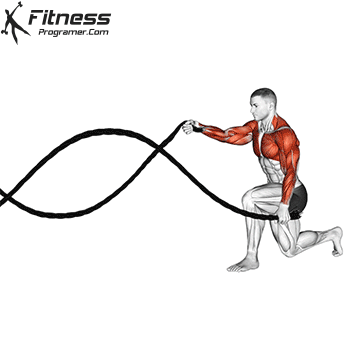
Benefits:
Incorporating half kneeling into your battle rope variations engages your core and upper body simultaneously. This battle rope variation challenges balance and stability, intensifying the effect on your core muscles while targeting your shoulders, arms, and back.
How to do:
- Begin in a half-kneeling position with one knee on the floor and the other foot bent.
- Hold one end of the battle rope in each hand.
- Perform various rope movements, such as waves, slams, or circles, while maintaining stability in your core and engaging your upper body muscles.
2. Alternating Waves with Kneeling Get-Ups:
This combines alternating waves with kneeling get-ups, adding a dynamic element to your workout by transitioning from kneeling to standing positions.
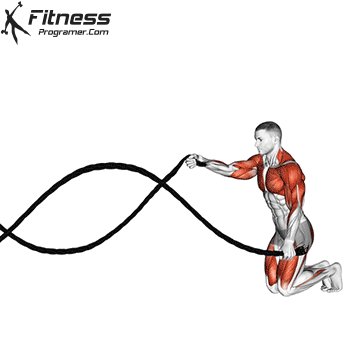
Benefits:
This exercise stimulates not only your upper body muscles but also enhances lower body stability and balance. Beginning in a kneeling position, you create alternating waves in the battle ropes, actively engaging your shoulders, arms, and core. Transitioning to standing one leg at a time adds an element of mobility and strength as you rise from kneeling to standing. By incorporating both waves and get-ups, you create an effective full-body workout that challenges multiple muscle groups simultaneously.
how to do:
- Begin in a kneeling position holding the battle ropes in front of you.
- Create alternating waves in the ropes.
- Transition from kneeling to standing position one leg at a time, while continuing the rope waves.
3. Battle Rope Power Slams:
This exercise involves lifting the battle ropes overhead and slamming them forcefully onto the ground, which targets your upper body, core, and even some lower body muscles.
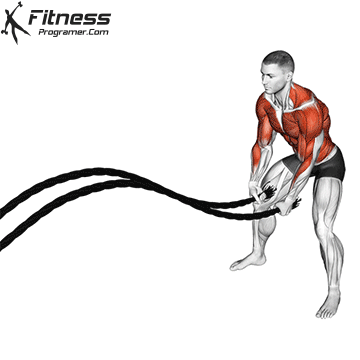
Benefits:
This high-intensity exercise channels your energy into lifting the battle ropes overhead and forcefully slamming them to the ground. The impact engages your upper body, primarily targeting your shoulders, arms, and core muscles. As part of battle rope variations, this exercise promotes explosive strength while releasing tension, making it a high-intensity choice for a full-body workout. Incorporating this dynamic exercise into your routine adds a burst of intensity, making your battle rope training both challenging and rewarding.
How to do:
- Stand with your feet shoulder-width apart, holding the battle ropes in both hands.
- Lift the ropes overhead, using your hips and legs to generate power.
- As you lift the ropes overhead, fully extend your arms.
- Forcefully slam the ropes down to the ground while simultaneously squatting down.
- Repeat the motion for a set number of repetitions.
4. Battle Rope Low Waves:
Holding the battle ropes low to the ground and creating waves targets your core and upper body muscles, especially the shoulders and back.
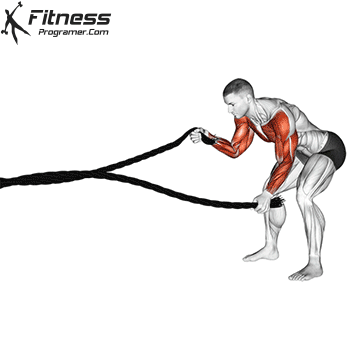
Benefits:
Battle rope low waves are a foundational variation that engages your core, shoulders, and back muscles while offering an effective cardiovascular workout. Executed by creating waves in the ropes while holding them at a lower level, this exercise emphasizes stability and controlled movement. The low wave motion challenges your core and lower back muscles to maintain balance, while your upper body works to create consistent waves. This battle rope variation is an accessible entry point to battle rope training, suitable for both beginners and experienced fitness enthusiasts.
How to do:
- Stand with your feet hip-width apart, holding the ropes in each hand.
- Bend your knees slightly and hinge at your hips to get into an athletic stance. (bent-over position)
- Keeping your core engaged, create waves in the ropes by moving your arms up and down in a controlled manner.
- Focus on maintaining a steady rhythm and consistent wave pattern.
5. Battle Rope High Waves:
Similar to the low waves, this involves creating waves in the ropes, but with your arms positioned higher, targeting the upper body muscles.
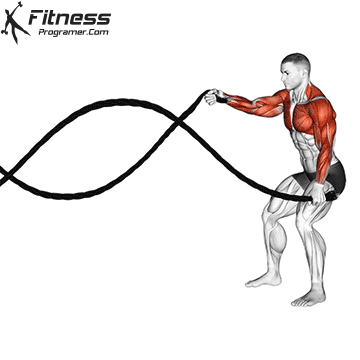
Benefits:
By positioning your arms higher and creating waves in the ropes, you engage your upper body in a different way compared to low waves. This exercise demands upper body strength and stability, encouraging you to maintain a steady rhythm while generating waves.
The higher arm position activates your shoulder muscles more intensely, promoting improved posture and overall upper body strength. Battle rope high waves provide a challenging workout that enhances both muscular endurance and cardiovascular fitness. This variation is particularly beneficial for individuals seeking to enhance their shoulder strength and upper body stability in an engaging and impactful manner.
How to do:
- Stand with your feet hip-width apart, holding the ropes in each hand.
- Similar to the low waves, create waves in the ropes, but this time raise your arms higher to generate larger waves.
- Keep your core tight and maintain a stable stance throughout the exercise.
6. Alternate Arms Jump Squat:
This exercise combines alternating arm movements with jump squats, providing a combination of upper body and lower body workout along with a cardio element.
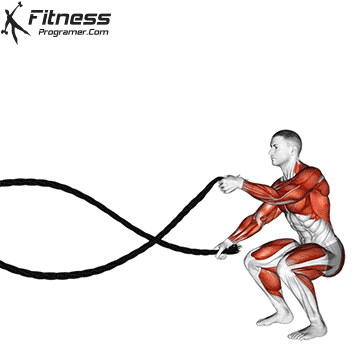
Benefits:
Combining explosive lower-body strength with upper-body engagement, this exercise is a high-intensity movement that promotes strength, coordination, and cardiovascular fitness.
Holding the ropes in each hand, you perform jump squats while simultaneously raising one arm overhead and lowering the other arm. This exercise challenges your leg muscles during the squat and engages your upper body and core muscles while controlling the rope motion.
The rapid switching of arm positions adds a dynamic element, keeping your heart rate elevated and promoting calorie burn. Incorporating battle ropes into jump squats boosts the intensity and effectiveness of the exercise, making it a valuable addition to your workout routine for enhancing full-body strength and power.
How to do:
- Hold the ropes in each hand with your arms extended by your sides.
- Start with a squat by bending your knees and lowering your hips.
- As you explode up from the squat, simultaneously raise one arm overhead and lower the other arm down.
- Land softly in the squat position and immediately transition into the next jump squat, switching the position of your arms.
- Continue alternating arm positions with each jump squat.
7. Alternating Lateral Lunge Waves:
You perform lateral lunges while simultaneously creating waves in the battle ropes, engaging your lower body muscles and core.
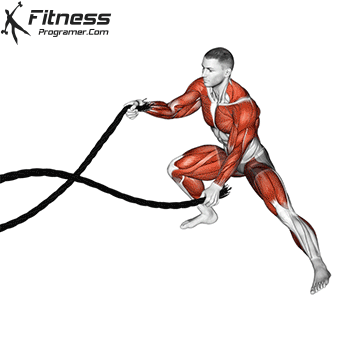
Benefits:
With battle ropes alternating lateral lunge waves, you combine lateral movement and upper body strength. This battle rope variation enhances mobility and stability while providing a unique way to engage multiple muscle groups. By targeting both upper and lower body, you achieve a well-rounded fitness routine.
How to do:
- Hold the ropes in each hand while standing.
- Take a step to the side to perform a lateral lunge, bending the knee of the lunging leg.
- Simultaneously, create waves in the ropes with your arms.
- Push off the lunging leg to return to the standing position and switch sides for the next repetition.
8. Battle Rope Wave Squats:
This exercise combines squatting movements with wave creation, targeting your leg muscles and incorporating a cardio component.
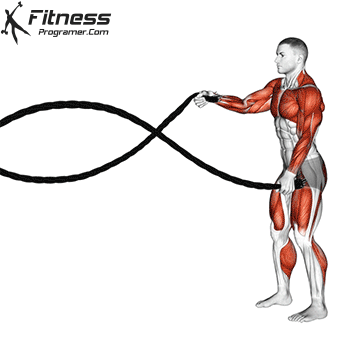
Benefits:
Battle rope wave squats offer a holistic full-body workout by combining squats with wave creation. This battle rope variation enhances muscular endurance and cardiovascular fitness. The integration of upper and lower body movement within battle rope variations promotes balanced strength development.
- Hold the ropes in each hand with your arms extended downward.
- Perform a squat by bending your knees and lowering your hips while simultaneously creating waves in the ropes.
- As you rise from the squat, continue the wave motion.
- Maintain proper form in both the squat and the wave creation.
9. Battle Rope Fly Whips:
This exercise involves swinging the ropes in a fly-like motion, engaging your shoulders, arms, and core muscles.
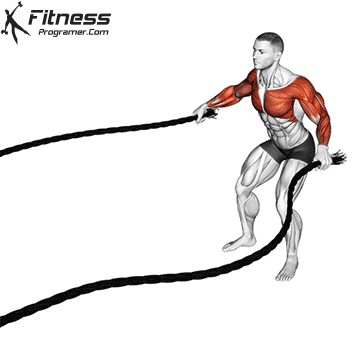
Benefits:
Differing from traditional battle rope movements, this battle rope variation involves swinging the ropes outward and back in a fly-like motion. The wider grip and swinging movement engage your shoulder muscles and core, demanding coordination and controlled execution. By incorporating this exercise, you enhance shoulder strength, stability, and controlled motion.
- Hold the ropes with a wider grip than usual.
- Begin by moving your arms outward and away from your body, then quickly bring them back in towards your body.
- Generate momentum in the ropes to create a “flying” motion with your arms.
- Maintain a stable stance and engage your core to control the movement.
10. Battle Rope Outside Circles:
Creating circular motions with the ropes works your shoulder muscles and upper body while also engaging your core for stability.
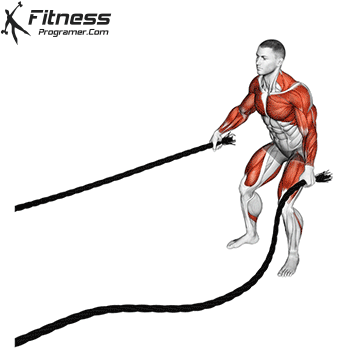
Benefits:
This battle rope variation primarily targets your shoulder muscles while involving your core for stability. By executing controlled circles, you cultivate shoulder strength and mobility, accentuating the significance of proper posture and alignment.
- Hold the ropes in each hand with your arms extended and parallel to the ground.
- Start by creating circular motions with your arms, moving them outward in wide circles.
- Control the speed and size of the circles based on your comfort and strength.
- Maintain proper posture and engage your shoulder muscles.
Getting Started Safely with Battle Ropes
1. Warm-Up is Essential
Begin with a light cardio warm-up, like 5-10 minutes of jumping jacks or jogging. Follow this with dynamic stretching, especially for your shoulders, arms, and wrists, to prepare your body for the intense, repetitive motions of battle ropes.
2. Select the Right Rope for You
Beginners might want to start with shorter, thinner ropes (about 30 feet in length and 1.5 inches in diameter). Gradually progress to longer, thicker ropes as you build strength and confidence.
3. Master Your Form
For most battle rope exercises, keep a slight bend in your knees, engage your core, and maintain a straight spine. Avoid hunching or bending over. Stand with feet shoulder-width apart, and ensure your movements are controlled and powerful.
4. Focus on Breath Control
Inhale through the nose and exhale through the mouth. Proper breathing can enhance your endurance and help stabilize your core during each movement.
5. Start Slow
If you’re new to battle ropes, start with shorter intervals—20-30 seconds of exercise, followed by a 20-30 second rest. Over time, build up your intensity and duration.
The Bottom Line
Battle ropes are a versatile, effective tool that can add intensity, calorie burn, and dynamic movement to your fitness routine. Whether you’re looking to improve endurance, build strength, or just try something new, incorporating battle ropes can help you achieve your goals faster.
Remember, battle rope exercises can be intense, so it’s essential to use proper form and start with an appropriate intensity level based on your fitness level. Additionally, ensure that you have enough space and a stable anchor point for the battle ropes before starting your workout. If you’re new to these exercises, consider seeking guidance from a fitness professional to ensure you’re performing them correctly and safely.
References:
- Fountaine C, Schmidt B. Metabolic cost of rope training. J Strength Cond Res. 2015;29:889–893. – PMID: 23897017
- Physiological Responses to Increasing Battling Rope Weight During Two 3-Week High-Intensity Interval Training Programs
- Journal of Strength and Conditioning Research: Metabolic cost of rope training
- Eight-Week Battle Rope Training Improves Multiple Physical Fitness Dimensions and Shooting Accuracy in Collegiate Basketball Players

